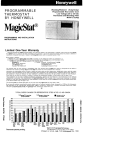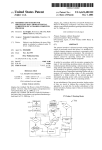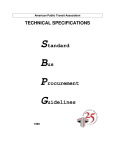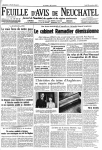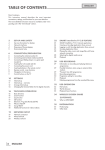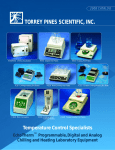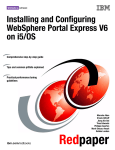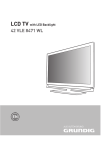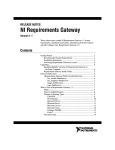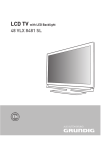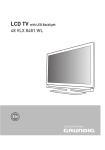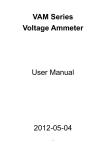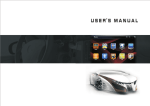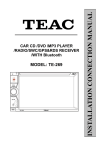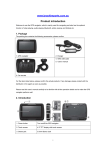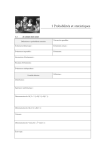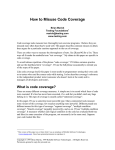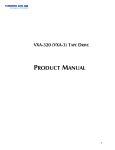Download Methods for automatically locating data
Transcript
US006630946B2
(12)
(54)
United States Patent
(10) Patent N0.:
Elliott et al.
(45) Date of Patent:
METHODS FOR AUTOMATICALLY
LOCATING DATA_C()NTAINING WINDOWS
4,827,406 A
4,870,644 A
IN FROZEN APPLICATIONS PROGRAM
(75)
(U-S)
Y
E_1Ydeta1-t---l ----------- -
,
in
5,124,989 A
Inventors: K
Scott
Je?'re
C. Elliott,
Perc Hillsboro,
Carr Ti ard
OR (US);
OR
Y
>
g
’
’
2
5,293,612 A
>
*Oct. 7, 2003
5/1989 Bischoff et al. .......... .. 711/153
9/1989 Sherry et al. ............ .. 714/47
2
,
AND SAVING CONTENTS
US 6,630,946 B2
say
e
a
.
. . . . .
6/1992 Padawer et al.
i
*
. . . ..
..... .. 714/38
5//
iomez
O-me - et
' ' ' 'al'
' ' ' ' ' """"""
'''"
/
3/1994 Shmgai .................... .. 711/159
(List continued on next page.)
(73) Assignee: Symantec Corporation, Cupertino, CA
(Us)
(*) Notice:
OTHER PUBLICATIONS
This patent issued on a continued pros-
dA1an”SimPS0n> “Mastering wordpgrfecg
ecution application ?led under 37 CFR
OWS ’ SYBEX’ 1994’ pp‘ 497’ 4 3_4
& 5-2 for Win‘
'
_
153w), and is Subject t0 the tWenty year
Margaret Levme Young et al, WordPerfect 6.1 for Windows
patent term provisions of 35 USC
for Dummies”, IDG Books Worldwide Inc., 2nd Edition,
154(a)(2)_
1993, pp. 335, 368*
Subject to any disclaimer, the term of this
(Llst Connnued on next page‘)
gusenct liszxéengei) (5r adlusted under 35
' ' '
( )
y
Primary Examiner—John Cabeca
ays'
Assistant Examiner—X. L. Bautista
(74) Attorney, Agent, or Firm—Fliesler Dubb Meyer &
(21) Appl. N0.: 09/438,076
(22) Filed:
NOV. 10, 1999
Lovejoy, LLP
(57)
(65)
A machine-automated system tries to save vital-data of a
crashed or otherWise frozen application program by: (a)
attempting to revive a program that has apparently become
51
(
Prior Publication Data
US 2002/0169795 A1 Nov, 14, 2002
I t C17
)
(52)
(58)
n '
'
G06F 3 00 G 0 6F 12 00
"""""""""""""" "
/
’
/
ABSTRACT
froZen; (b) identifying the apparently-frozen program; (c)
identifying one or more Windows Within the identi?ed
US. Cl. ..................... .. 345/781; 345/803; 345/806;
_
345/853; 707/202; 711/161
Field of Search ............................... .. 345/326, 339,
program that are most likely t0 immediately Contain data
Which the user is likely to consider as vital and in need of
Saving; (d) Sending one or both of a SAVE and a CLOSE
345/340, 356, 700, 764, 781, 853, 803,
806; 707/202—204; 709/313, 316, 317,
328; 711/161—162
command message to each of the identi?ed one or more
Windows so as to thereby cause that Window to itself save its
vital data contents and to thereafter gracefully close itself. A
(56)
R f
e erences
Ct d
pro?ling database may be constructed for helping to identify
the vital data-containing Windows of both popular (Well
known) and obscure application programs. One such pro
?ling database has ID records Which de?ne parent/child
1 e
U.S. PATENT DOCUMENTS
4,514,846 A
4/1985 Federico et al. ............ .. 714/45
hierarchy relationships betWeen vital data-containing Win
4,521,847
A
6/ 1985
Ziehm et al.
........
. . . ..
700/79
doWs and other Windows of various application programs.
4,580,232
A
4/1986
Dugan et al.
........
. . . ..
399/77
4,589,090 A
5/1986 Downing et al.
4,811,216 A
3/1989 Bishop et al. ............ .. 711/153
714/10
26 Claims, 7 Drawing Sheets
APP 1m | m
PROGRAM
sKIFs
NGDF
wow
nDucr
453
453
J
455
/
US 6,630,946 B2
Page 2
Adaptec, Inc.; GoBack: The Power to Undo PC Problems—
US. PATENT DOCUMENTS
5,321,824 A
5,335,344
*
A
5,410,685 A
5,493,649
A
6/1994 Burke et al. .............. .. 711/220
8/1994
Hastings
.......
. . . ..
4/1995 Banda et al. ..
*
2/1996
Slivka et al.
.....
714/35
714/38
. . . .. 714/48
Adaptec, Inc.; GoBack: The Power to Undo PC Problems on
Shared or Workgroup Computers—data sheet; http://www.
adaptec.com/products/datasheets/gobackprofessionalhtml;
5,515,493 A
5/1996 Boston et al. .
5,526,485 A
5,530,864 A
6/1996 Brodsky .................... .. 714/38
6/1996 Matheny et al. ...... .. 709/328 X
Jul. 21, 2000; pp. 1—3.
9/1996 Connors et al. ..
711/100
GoBack;
711/170
html; Oct. 16, 2000; pp. 1—2.
Adaptec, Inc.; GoBack: Product Tour—restoring the system,
*
5,559,980 A
345/807
data sheet; http://www.adaptec.com/products/datasheets/go
back.html; Jul. 21, 2000; pp. 1—3.
5,561,786 A
10/1996
5,568,635 A
10/1996 Yamaguchi
5,581,696 A
5,581,697 A
12/1996 Kolawa et al. ............. .. 714/38
12/1996 Gramlich et al. ........... .. 714/35
5,696,897
12/1997
A
5,701,484 A
Morse ........ ..
Dong
711/171
... ... ... ..
* 12/1997 Artsy ......... ..
5,712,971 A
1/1998 Stan?ll et al. .
5,748,882
5/1998
A
5,812,848 A
Huang
.. ... ... ..
. . . ..
9/1998 Cohen ........ ..
5,815,702 A
5,819,022
. . . ..
10/1998
5,857,204 A
5,857,207 A
5,911,060 A
Bandat
714/16
703/22
?le; http://adaptec.com/products/tour/goback3.html; Oct.
Elliott
.. ... ... ..
. . . ..
3/2000
Chung et al.
Elliott
705/30
.....
.. ... ... ..
. . . .. 714/15
6,173,291 B1 *
1/2001
Jenevein ..... ..
6,182,243 B1
1/2001
Berthe et al. ............... .. 714/38
6,269,478 B1
7/2001 Lautenbach-Lampe
. . . ..
703/22
707/202X
et al. ........................ .. 717/127
B1
6,405,325 B1
6,438,709 B2
6,438,749 B1
goback2a.html; Oct. 16, 2000; pp. 1—2.
goback2b.html; Oct. 16, 2000; pp. 1—2.
Adaptec, Inc.; GoBack: Product Tour—recovering a deleted
11/2000
6,389,556
written ?le, step 1; http://www.adaptec.com/products/tour/
written ?le, step 2; http://www.adaptec.com/products/tour/
*
6,330,528 B1
html; Oct. 16, 2000; pp. 1—3.
Adaptec, Inc.; GoBack: Product Tour—recovering an over
714/15
703/27
12/1999
A
step 2; http://www.adaptec.com/products/tour/gobacklb.
709/100
Elliott ........ ..
6,009,258
A
714/34
714/47
6/1999
6,009,414 A * 12/1999 Hoshiya et al.
6,151,569
step 1; http://www.adaptec.com/products/tour/gobackla.
707/202
707/203
8/1999 Damani et al.
10/1999 Elliott et al.
6,044,475
Product Tour—introducing
1/1999 Lordi et al.
1/1999 Lo et al.
5,938,775 A
5,974,249 A
A
. . . ..
GoBack:
http://www.adaptec.com/products/tour/goback.
html; Oct. 16, 2000; pp. 1—2.
Adaptec, Inc.; GoBack: Product Tour—restoring the system,
712/244
. ... ... ..
Inc.;
709/316
714/15
709/331
9/1998 Kannan et al.
A
Adaptec,
12/2001 Huang et al. ..
5/2002
Qureshi
... .. ...
. . . ..
Adaptec, Inc.; GoBack: Product Tour—recovering an over
16, 2000; p. 1.
Adaptec, Inc.; ReZOOM: Technology Comparison; http://
adaptec.com/technology/overview/reZoom.html; Jul. 21,
2000; pp. 1—5.
Adaptec, Inc.; ReZOOM Compatibility Update; http://ww
w.adaptec.com/support/compatibility/rezoomhtml; Jul. 21,
703/22
2000; pp. 1—2.
714/15
Adaptec, Inc.; ReZOOM: Product Tour—Setup ReZOOM;
http://www.adaptec.com/products/tour/reZoom1.html; Oct.
6/2002 Lin et al. .................... .. 714/15
8/2002 Poisner ...................... .. 714/23
8/2002 Chamberlain ............. .. 717/174
OTHER PUBLICATIONS
Larry Brown et al, “Dynamic Snooping in a Fault—Tolerant
Distributed Shared Memory,” IEEE, pp. 218—226.*
“First Aid® 97 Deluxe, User Manual,” CyberMedia, Inc.,
1996, pp. i—viii, 1—123.
“Vertisoft FiX—ItTM For Windows 95,” User’s Guide, Verti
soft System, Inc., Jun. 1996, pp. i—vii, 1—86.
“WINProbe 95”‘ User Guide,” Quarterdeck Corp., 1996,
pp. i—vi, 1—88.
Adaptec, Inc.; GoBack: Product Tour—viewing your drive
16, 2000; pp. 1—3.
Adaptec, Inc.; What resellers are saying about ReZOOm;
http://www.adaptec.com/adaptec/testimonials/reZoom.html;
Jul. 21, 2000; pp. 1—2.
Adaptec, Inc.; ReZOOM: All—In—One Protection To Elimi
nate PC Downtime—product overview; http://www.
adaptec.com/products/overview/reZoom.html; Jul. 21, 2000;
pp. 1—3.
Adaptec, Inc.; ReZOOM: All—in—one Protection to Elimi
nate PC Downtime—ReZOOM Features; http://www.
adaptec.com/products/overview/reZoomfeatures.html; Jul.
goback4.html; Oct. 16, 2000; pp. 1—2.
21, 2000; pp. 1—4.
Adaptec, Inc.; ReZOOM: All—In—One Protection To Elimi
nate PC Downtime—data sheet; http://www.adaptec.com/
products/datasheets/reZoom.html; Jul. 21, 2000; pp. 1—4.
Adaptec, Inc.; GoBack Product Reviews; http://adaptec
.com/products/overview/gobackreviews.html; Jul. 21, 2000;
Adaptec, Inc.; ReZOOM Product FAQs; http://www.
adaptec.com/products/faqs/reZoom.html; Jul. 21, 2000; pp.
as it was in the past; http://www.adaptec.com/products/tour/
pp. 1—5.
1—5.
Adaptec, Inc.; What GoBack Users are Saying; http://ww
Adaptec, Inc.; ReZOOM: Product Tour—Setup ReZOOM,
cont.;
http://www.adaptec.com/products/tour/reZoom1b.
w.adaptec.com/adaptec/testimonials/goback.html; Jul. 21,
2000; pp. 1—3.
html; Oct. 16, 2000; pp. 1—3.
Adaptec, Inc.; GoBack Product Awards; http://www.
adaptec.com/products/overview/gobackawards.html; Jul.
Adaptec, Inc.; ReZOOM: Product Tour—Testing Recovery;
http://www.adaptec.com/products/reZoom2.html; Oct. 16,
21, 2000; pp. 1—3.
2000; pp. 1—2.
Adaptec, Inc.; ReZOOM Multimedia Presentations; http://
www.adaptec.com/products/tour/rezoomim.htnl; Jul. 21,
Adaptec, Inc.; ReZOOM: Product Tour—Using ReZOOM;
http://www.adaptec.com/products/tour/reZoom3.html; Oct.
2000 p. 1.
Adaptec, Inc.; GoBack: The Power to Undo PC Problems—
16, 2000; pp. 1—3.
Adaptec, Inc.; ReZOOM: Product Tour—ReZOOM Recov
product overview; http://www.adaptec.com/products/over
ery; http://www.adaptec.com/products/tour/reZoom4.html;
view/goback.html; Jul. 21, 2000; pp. 1—3.
Oct. 16, 2000; pp. 1—3.
US 6,630,946 B2
Page 3
Pietrek, M., “Windows TM 95 System Programming
SecretsTM,”IDG Books Worldwide, Inc., 1995, pp. 692—694.
Richten J~> “Advanced Wind9WSTM> The Developer’s Guide
US. patent application Ser. No. 09/438,135, Lopez et 211.,
?led Nov. 10, 1999.
US. patent appliction Ser. No. 09/438,020, Zeigler et 211.,
to the WIN 32® API for WindoWs NTTM 3,5 and WindoWs
?led NOV_ 10, 1999_
95,” Microsoft Press, Copyright 1995, pp. 809—838,
848—858.
* cited by examiner
U.S. Patent
Oct. 7, 2003
Sheet 2 0f 7
US 6,630,946 B2
OS HANDLE= 991014 -J211a
213
F
[OUTERMOST WINDOW]
I
2148
OS HANDLE= 991019
CAPTION: "WORD PROCESS"
I
I
214b
2146
kl PW HANDLE= 991014
Tlizmd
CLASS:“WORDPERFECT.7.32"
CONTROL ID ="[none]"
| T2146
2141
|
....OTHER ATTRIBS
Y 212
~
TT
[TOP MENU BAR WINDOW]
Os HANDLE= 991021
CAPTION: "CS7_Command_Ba1"
Q———— PW HANDLE= 991019
215
I
2158
4| L 2151,
I
2150
—§I 215d
CLASS= "MSO__COmmand_Bar"
—I5 2156
CONTROL ID ="A.1"
TJI 215f
....OTHER ATTRIBS
4|
I’ 215
I
[TOP RIGHT PUSHBUTTONS]
I
I
O8 HANDLE= 991022
I
I
CAPTION: "[none]"
a—— PW HANDLE= 991019
I
CLASS= "BUTTONS"
|
II
I
216
J
a
I
-216b
I
2166
—'SI 216d
J 2168
I
CONTROL ID = A2
II
__!_5'
'
....OTHER ATTRIBS
T5’
I
2161‘
f 211
I
2178
OS HANDLE= 991023
[DOCS CONTAINER]
I
217b
CAPTION: "[0009]"
| T 217C
| y 217d
I 2178
@-——- PW HANDLE= 991019
CLASS= "MD|_CL|ENT'
CONTROL :0 ="A.3"
I g" 21”
....OTHER ATTRIBS
4
[DOC_1 WINDOW]
I
fm
I 2183
0s HANDLE= 991024
I
.218b
CAPTION: "Document 1"
I
2180
I
F PW HANDLE= 991023
g
I
CLASS: "WP__DOC_FRAME"
218d
if
I 2188
I
I
CONTROL ID ="B.2"
J 218T
'
OTHER ATTRIBS
TU
U.S. Patent
F_
Oct. 7, 2003
3
_9-__
Sheet 3 6f 7
\
US 6,630,946 B2
340
3 O
RuN
310
NEW
APPLICATION
<5 ———— -;
PROGRAM
:
I
FOR
DATABASE
LOCATING
VITAL WINDOWS
:
g
342
I
l
POPULAR
COMMERCIAL
APPLICATION
I
:
311
344
I
PROGRAMS f\\_/
l
I
OTHER
COMMERCIAL
MANUAL ID
;
OF VITAL
I
WINDOW(S)
I
:
APPLICATION
312
PROGRAMS \/
:
;
45
GEN AUTO
lI
ENABLE ID
I
I
I
FOR VITAL
l
I
I
I
I
I
I
318
l
l
l
|
350
PGM_NAME='WORDX.“32"
NAV_PATH=
{OUTER CLASS= "WwB"}/
{LEVEL_A CLASS="MDI"' AND
ID RECORD
-330
LEVEL_A CAPTION="'MENU*"}/"I
{LEVEL_C CLASS: "WPDOC?.32"}
OBSCURE
APPLICATION
PROGRAMS
SAC_MSSG="WM__CLOSE"
L 355
/
USE TO
360
AUTO ID
VITAL DATA
WINDOWS
SOK_MSSG="ENTER_KEY"
‘~35?
W
U.S. Patent
0a. 7, 2003
7D
440'
Sheet 4 6f7
00
US 6,630,946 B2
. 4
APPLICATION
PROGRAM
RUNNING
443
441
USER
GUARD PGM
PERCEIVES A
DETECTS A
FREEZE
FREEZE
444
442
AUTO
INVOKE OF UN-FREEZE
DIALOG
MANUAL
INVOKE OF UN-FREEZE
TERMINATE
SKIP SAVING OF
WORK PRODUCT
ANTI-FREEZE
VITAL~SAVE
462
453
463
REVIVE
ATTEMPT
410
464
468
\'\
REVIVE
ATTEMPT
I
465
USER
MANUALLY
SAVES
WORK
VITAL PGM
AUTOMATICALLY
IDENTIFIES & SAVES
PRODUCT
WORK
PRODUCT
INTELLIGENCE
DATABASE
U.S. Patent
0a. 7, 2003
Sheet 5 0f 7
US 6,630,946 B2
Fig. 5
sTART AT TOP OF
5/1O
~—>‘ ID RECoRDs DATABASE
(E.G., 310/410)
502
501
V
sELECT A NExT ID RECoRD
511 ’\ (E.G., 35o)
NONE
' """""""""""" ‘ if
|
519
l
525
|
I
TEsT FOR PGM_NAME
SATISFACTION
_
OK \ 522
EXIT
V
>
\
529
START AT HIE RARCHY
/
530
A
NOT SATISFIED
——————————— — -
LEVEL OF ouTERMosT
FRAME WINDOW
NOT
TOP
V
J
GET NAV SATISFACTION RULE
J40
FOR CURRENT HIERARCHY
LEvEL FROM DATABASE
T53‘;
/
l
DECREMENT
FIND ANExT WINDOW AT CURRENT HIERr“ ARCHY LEvEL THAT sATIsFIEs NAV RULE
550
“'52 LEVEL
A '
FOR CURRENT HIERARCHY LEvEL
S
NONE
\
\.\
’
MARK
CURRENT
HIER LEvEL
As EXHAUSTED
555
wAs THIS LAsT
YES
f]
CHILD IN NAV_PATH
557
569
560
570
'NCREMENT
RETURN 0s HANDLE
OF CURRENT wINDow
H'ER LEVEL
AS A MATCH REsULT
I
EXIT
559
U.S. Patent
0a. 7, 2003
US 6,630,946 B2
Sheet 6 0f 7
610
TRY TO IDENTIFY NAME
OF JUST-REVIVED PRO
FAILED
GRAM
I
I
I
f’
619
I
SELECT ONLY ID RECORDS
I 611 ’\ (E.G,, 350) WITH MATCHING
I
|
PGM NAME
I
TRY TO ISOLATE A RULES RECORD
620
<
CONTINUE
> T0 STEP 640
WHOSE NAV_PATH SATISFACTION
RULES MOST TIGHTLY CONFORM WITH
ONE OR MORE TO-WINDOW NAVIGA
TION PATHS FOUND WITHIN THE JUST
REVNED 8. IDENTIFIED PROGRAM OR
WITHIN DESKTOP
A, 641
FOUND
/\J
2
v
6 1
640
P’
DE-SUSPEND THE JUST
REVIVED PROGRAM 440/124
SO THAT THE OPERATING SYS
TEM BEGINS GIVING TASK TIME
TO THE REVNED PROGRAM
FAILED
SEARCH THE DATABASE
)
410 AND TRY TO LOCATE
WITHIN DATABASE 410, A
630
GENERALIZED OR
OBSCURE RULES RECORD
WHOSE SATISFACTION
RULES CONFORM IN A REL
ATIVELY TIGHT WAY WITH
ONE OR MORE OF TO
WINDOW NAVIGATION
PATHS FOUND WITHIN THE
JUST-REVIVED & IDENTI
FIED PROGRAM OR WITHIN
DESKTOP
FAILEDh 639
EXIT
FOUND
631
U.S. Patent
Oct. 7, 2003
Sheet 7 0f 7
gig“; Ff
US 6,630,946 B2
Fig. 6B
640
SELECT A FIRST, OR THE NEXT BEST WINDOW
THAT IS GUESSED BY ANY ONE OR MORE OF
645
STEPS 601-640 TO CONTAIN V‘TAL DATA WHICH
V
Is IN NEED OF SAVING
-\
I
W
\
OPTIONALLY MONITOR
THE wINOOws ENvI
RONMENT TO SEE IF
661
650
THE
SAVlNG/SHUTTING-
A
V
gg‘mvvgwzg‘gggf
OR OTHER MESSAGE
THAT NEEDS To BE
RESPONDED To IN
SEND MESSAGE(S) (E.G., wM_CLosE) OR INSTRUC
1
TIoNs To WHAT Is GuEssEO TO BE A vITAL DATA
\ CONTAINING WINDOW FOR CAUSING THAT GuEssEO
WINDOW TO ITSELF sAvE ITs OwN DATA
ORDER To KEEP THE
SAVE~AND-SHUT-
_ _
DOWN PROCESS MOv-
ING FORWARD UNABATED
\
’
\
I
’
\f
ON AN AUTOMATIC
_
-
T ' ' ' " T T ' ' T T T.
I
:
INHERENTLY, OR OPTIONALLY, cAusE
GUESSED wINOOw TO SHUT ITsELF DOWN
I
As CLEANLY As POSSIBLE
1
K
TO EXTENT POSSIBLE
- ‘
\
:
TTTTTTTTTTTTTTT "'
660
BASIS, ANswER THE
L’_\
WAIT FOR SAVE-AND/OR-CLOSE
DIALOG BOX OR OTHER
655
T0 COMPLETE
/\
MEssAGE IN A MANNER
wHICH WILL KEEP THE
670
SAVE-AND-SHUT-DOWN f\
PROCESS MOVING FORWARD UNABATED
'
675
554
If
AUTOMATICALLY
ANY MORE WINDOWS
DETECT FURTHER
To SAVE-AND-CLOSE '2
FREEZINGS AND
AUTOMATICALLY
ATTEMPT To AGAIN
REvIvE THE RE
YES
N0
\/
INSTRUCT THE usER To
FROZEN PROGRAM
sHuT DOWN THE
PICK THE OPTION IN THE
PROCESS-ABATING DIALOG BOX THAT IS LEAsT
LIKELY TO BLOCK CON-
so As TO CONTINUE THE CARRYING
OuT OF THE SAVE
AND~SHUT-DOWN
MAIN PROGRAM
TINUED
CARRYING OUT
OF THE SAVE-AND-
ggggggi 538525.
SHUT_DOWN PROCESS
WAL DATA
_ CONTAINING WIN_
DOW
'
r]
668
\/-\
680
682
/
RELAuNcH A FRESH (NOT
CORRUPTED) COPY OF THE
FROZEN-ANDHAFTERWARDS
REvIvEO PROGRAM
/”
672
/
A684
RE-LOAD INTO FRESH COPY
OF THE PROGRAM, THE DATA
THAT HAD BEEN SAVED
US 6,630,946 B2
1
2
METHODS FOR AUTOMATICALLY
LOCATING DATA-CONTAINING WINDOWS
IN FROZEN APPLICATIONS PROGRAM
AND SAVING CONTENTS
Preemptive multitasking systems may be characteriZed as
those in Which an operating system (OS) has supervisory
control over the concurrently executing programs and the
OS limits the length of time that each given application
program has for using system resources such as a CPU
(Central Processing Unit) or other data processing means.
BACKGROUND
Examples of preemptive multitasking OS’s include
1. Field of the Invention
Microsoft WindoWs95TM, Microsoft WindoWs98TM and
The invention relates generally to computer systems that
concurrently execute plural application programs on a pre
emptive multitasking basis.
Microsoft WindoWs NTTM, all of Which are available from
10
The invention is directed more speci?cally to multitasking
systems Wherein the execution of a given application pro
threaded execution, a program begins executing as a ?rst,
main thread and optionally generates ancillary threads that
gram may become frozen or may otherWise halt unexpect
edly and for Which it is desirable revive the froZen/-halted
run concurrently and interact With one another through
15
application program at least partially so as to enable non
encounter an unexpected problem Which halts its normal
frozen program. The invention is directed even more spe
execution either in a main thread or an ancillary thread.
20
2a. Cross Reference to Related Patents
The disclosures of the following US. patents are incor
services Without the ability to handle such unavailability, (c)
the program jumps into a nonsense stream of execution
25
RATUS FOR UNFREEZING AN APPARENTLY FROZEN
APPLICATION PROGRAM BEING EXECUTED UNDER
CONTROL OF AN OPERATING SYSTEM; and
(B) US. Pat. No. 5,974,249 issued Oct. 26, 1999 to Scott
Elliott et al, and entitled, ZERO FOOTPRINT METHOD
30
AND APPARATUS FOR EXPANDING ALLOCATED
MEMORY SPACE OF A PROCESS USING A VIRTUAL
MEMORY AREA.
2b. Cross Reference to Co-Pending Patent Applications
The disclosures of the folloWing Co-pending, US. patent
applications (each oWned by the oWner of the present
code, (d) the program invokes a no-time-out Wait for an
event that never happens, (e) the program enters into a
deadlock embrace, and so forth. This is a nonexhaustive list
of possible causes.
When such execution-halting events occur, artisans some
times refer to the halted program as being ‘stuck’ or ‘froZen’
or ‘crashed’ or as having encountered a ‘fatal error’. Dif
ferent ?avors of these terms are sometimes associated to one
class of cause as opposed to another. Here, the terminology
35
application) are incorporated herein by reference:
(A) US. Ser. No. 08/938,204, ?led Sep. 26, 1997, by
inventor Scott Elliott and originally entitled COMPUTER
Examples of causes for such problems include those in
Which: (a) the program attempts to access restricted
(privileged) or unavailable areas of memory areas, (b) the
program makes calls to unavailable system functions or
porated herein by reference:
(A) US. Pat. No. 5,911,060 issued Jun. 8, 1999 to Scott
Elliott, and entitled, COMPUTER METHOD AND APPA
exchanges of semaphores.
During execution, a given application program may
volatile saving of Work product produced so far by the
ci?cally to the problem of hoW to appropriately save Work
product items of a just-revived application program.
Microsoft Corporation of Redmond, Wash. These OS’s also
permit multi-threaded execution of programs. In multi
‘froZen application’ Will be generically applied to any and all
situations in Which the user of a given application program
reasonably believes the program is stuck and therefore
prevents saving of Work product irrespective of the exact
40
cause and irrespective of Whether that belief is accurate in
fact.
METHOD AND APPARATUS FOR ACCESSING AN
The end-user (e.g., novice user) of a computer system
APPLICATION PROGRAM WHICH HAS BECOME
typically doesn’t care What the speci?c cause is that has led
UNRESPONSIVE TO MESSAGES FROM THE OPERAT
him or her to believe that they can no longer save Work
ING SYSTEM OR INCURRED A FATAL ERROR, Which
product. Such a user instead generally recogniZes the ‘fro
application later issued as US. Pat. No. 6,009,258; and
45 Zen’ condition as an apparently sudden refusal by the given
(B) U.S. Ser. No. 09/275,171, ?led Mar. 24, 1999 as a
application program to respond appropriately to keyboard
divisional of US. Ser. No. 08/937,629, ?led Sep. 26, 1997
by inventor Scott Elliott and originally entitled COM
strokes or to mouse clicks or to other user interface inter
actions (Which interactions can include voice commands,
hand gestures, and so forth).
PUTER METHOD AND APPARATUS FOR UNFREEZ
ING AN APPARENTLY FROZEN APPLICATION PRO
GRAM BEING EXECUTED UNDER CONTROL OF AN
OPERATING SYSTEM.
The presence of a froZen program does not generally pose
a major problem to the overall operations of a preemptive
multitasking system. In such systems, other, concurrently
2c. Copyright Notice
executing application programs can continue to run in
This application includes one or more listings of computer
normal fashion even though a given application has actually
become froZen or has actually crashed (as opposed to
programs. The assignee of the present application claims
certain copyrights in said computer program listings. The
assignee has no objection, hoWever, to the reproduction by
others of these listings if such reproduction is for the sole
purpose of studying it to understand the invention. The
assignee reserves all other copyrights in said program list
55
situations Where the program is ?ne and the user merely
believes it has become stuck). The end-user continues to
have access to operating system services and to the
resources of non-froZen application programs. (For
60
example, in a WindoWs95/98TM environment the user may
65
hit the Alt-Tab key combination to sWitch to the next task.)
The user may choose to simply end the tasking of the
apparently-froZen program and to thereafter restart the pro
gram afresh from its basic start-up state.
Sometimes, this close-and-restartiafresh option is not an
ings including the right to reproduce the corresponding
computer programs in machine executable form.
3. Description of Related Art
Multitasking computer systems may be characteriZed as
those that alloW multiple programs to execute in overlapping
fashion so that it appears the programs are all running at the
same time.
attractive one for the end-user. It may be that the end-user
did not, or believes he did not, save to nonvolatile memory
US 6,630,946 B2
3
4
(e.g., to hard disk), a segment of Work that he/she last
end user may ?nd that the mouse-driven SAVE FILE func
tion of the program has become inoperative. The user may
performed With the application just before the given appli
cation became froZen. Closing-and-restarting the froZen
not knoW What else to do for saving the Work product data.
Also, the user may have multiple spreadsheets or multiple
program afresh may mean that the unsaved Work may be lost
forever. Many hours of Work may have to be painfully
redone to reconstruct the state of the application just before
it apparently became froZen. In some instances, the pre
freeZe state of the application may represent non
replicatable Work product such as data that had just been
captured and/or transformed in real-time.
other Work product objects (e.g., Word processor documents)
left open and in need of saving. The user may become
confused and try to use inoperative parts of the just-revived
program instead of immediately saving all unsaved Work
product.
10
The present invention provides methods and systems
To remedy this predicament, various un-freeZing tech
niques have been developed. These try to revive the froZen/
Which may be used as automated alternatives to alloWing an
crashed program at least to a suf?cient level such that
process in a just-revived program.
end user to manually control the Work product saving
unsaved Work product may be accessed and saved either
Wholly or partially. Examples of such un-freeZing tech
A number of separate aspects of a multi-threading,
patent applications.
WindoWs-oriented operating system (OS) are employed
No currently knoWn revival technique is 100% effective
for all possible forms of application program. One may
make an analogy to attempts to revive a human patient by
here. These include: detection of a possible freeZe and
attempted revival of an apparently-froZen program, analysis
of the parent/child WindoWs hierarchy in the just-revived
CPR (cardio-pulmonary resuscitation) after the patient suf
fers a cardiac arrest. In some cases, the patient is fully
revived. In other cases, the patient is revived but still suffers
from serious complications. And in yet further cases, even
heroic attempts to revive the patient regretfully prove unsuc
program, and automatically passing of messages to appro
priate child WindoWs to cause those WindoWs to themselves
save their data contents and/or immediately thereafter close.
When an un-freeZe request is presented, and a Vital
25
SaveTM option is selected (VitalSaveTM is a trademark of
cessful. In so far as reviving a froZen application program is
Symantec Corp.), an appropriate revival procedure (Which
concerned, the end goal is not to keep the application
could include doing nothing) is automatically selected and
program alive and Working as long as possible, but rather to
carried out. Thereafter, an automatic identi?cation is made
of one or more WindoWs of the just-revived program that
keep it alive long enough so that vital, but still unsaved,
Work product can be saved.
most probably contain (immediately in such identi?ed
One un-freeZing technique tests the apparently-froZen
WindoWs), vital data that the user Would most likely Want to
application to see if the cause of the freeZe is a ‘soft event’
save. One or both of a SAVE and CLOSE message is
(Where the application continues to respond to messages
from the OS) or a ‘hard event’ (Where the application is not
longer responding to messages from the OS). If it is a ‘soft
event’, the un-freeZing technique may try to CLOSE or
SUMMARY OF THE INVENTION
15
niques include those disclosed in the above-cited patents and
automatically sent to each identi?ed one of the vital-data
35 containing WindoWs so as to cause that WindoW to itself save
its oWn vital-data, and thereafter optionally close itself.
A machine-implemented, vital-data saving method in
accordance With the invention comprises the steps of: (a)
CANCEL the currently ‘active’ WindoW under the theory
that such an ‘active’ WindoW is simply a hidden dialog box
that is expecting a user response, but is not getting it because
attempting to revive a program that has apparently become
froZen and identifying that apparently-froZen program; (b)
the user does not see the hidden dialog box.
If the cause of the freeZe is determined to be a ‘hard
identifying one or more WindoWs Within the identi?ed
program that are most likely to immediately contain therein
data Which the user is likely to consider as vital and in need
of saving; (c) sending one or both of a SAVE and a CLOSE
event’, the un-freeZing technique may try to continue the
execution of the froZen application program by entering the
execution stream of the froZen program at a point Where 45 command message to each of the identi?ed one or more
continued execution Will probably preserve the application’s
WindoWs so as to thereby cause that WindoW to itself save its
state just before the encounter With the freeZe-causing event.
HoWever, even if this attempt is fully or partially successful,
vital data contents and to thereafter optionally close itself.
Other features and aspects of the invention Will become
determining speci?cally What data Within the revived pro
gram should be saved and exactly hoW to go about saving it
is still a problem.
Conventionally, after a revival technique is applied to a
apparent from the beloW detailed description.
BRIEF DESCRIPTION OF THE DRAWINGS
The beloW detailed description makes reference to the
‘hard’ failure event, a message is sent to the user to go ahead
and try to immediately save their Work product to nonvola
tile memory and to then immediately shut doWn the appli
accompanying draWings, in Which:
55
cation program. In some instances, the end user ?nds that
these instructions are very easy to folloW. The application
program appears to be fully resuscitated and the end user
invention;
FIG. 2Ais a block diagram of a computer system that may
may quickly forget that the program just suffered a serious
be con?gured to operate in accordance With the invention;
FIG. 2B is an example of a WindoWs hierarchy chart;
problem. The user may be able to easily maneuver the cursor
to a SAVE FILE function on the program’s menu bar and
invoke a ?le saving operation. Sometimes the user may be
so lucky as to be able to continue Working as if nothing
FIG. 3 illustrates a database building system in accor
dance With the invention;
Wrong had just happened, although such continuing of Work
de?es the instructions given to the user.
In other cases, the end user’s ability to folloW the post
revival instructions turns out to be more complicated. The
FIG. 1 is a perspective vieW shoWing a computer system
that may be con?gured to operate in accordance With the
FIG. 4 is a How chart shoWing hoW a vital save activation
65
?ts in Within a composite of other revival and save options;
FIG. 5 is How chart shoWing details of a vital save
operation in accordance With the invention; and
US 6,630,946 B2
5
6
FIGS. 6A—6B combine to de?ne a How chart showing
broader aspects of a vital save operation in accordance With
the invention.
grandparent WindoW frame 114 are referred to herein as
LeveliA inner frames or more simply as LeveliA ‘parent’
WindoWs. Immediate children of the LeveliA inner frames
DETAILED DESCRIPTION
simply as IJeveliB child WindoWs. Each LeveliB WindoW
are referred to herein as IJeveliB inner frames or more
may have its oWn, LeveliC children and so forth. Atree-like
FIG. 1 illustrates a perspective vieW of an overall com
organiZational chart (see FIG. 2B) may be draWn to shoW
puter system 100 that may be programmably con?gured to
Which WindoW is a child of Which other WindoW. Such a
chart is knoWn in the art as a WindoWs hierarchy chart.
operate in accordance With the invention. This vieW Will be
used to explain a dilemma that can confront users When an
By Way of a more concrete example, consider in FIG. 1,
the topmost menu bar 115 in the application program
in-use application program freezes or crashes before the user
has had a chance to nonvolatily save Work that is in progress.
WindoW 114. This bar 115 Will normally appear to a user as
The illustrated computer system includes a display moni
tor 110, a computer housing 120, a keyboard 130 and a
a seamless and integral part of outermost WindoW 114.
HoWever, for purpose of this disclosure, bar 115 is shoWn for
mouse 140. The illustrated user input and output devices
110, 130 and 140 are merely examples. Other to-user output
devices and from-user input devices may, of course, be used
15
What, under usual circumstances, it really is to the operating
system, namely, a LeveliA child of grandparent WindoW
in addition to or in place of the illustrated devices. Mouse
114. Menu bar 115 is also referred to herein as a ParentiA.1
WindoW so as to distinguish it from other IJeveliA children
140 for example can be replaced by or supplemented With
of grandparent WindoW 114.
other graphically-oriented user input devices such as
Consider next the combination of the main WindoW’s
“minimize” button (symboliZed as a minus sign in a square),
trackballs, touch pads, joysticks, and so forth. Voice input
and/or output interfaces are contemplated in addition to the
illustrated visual and tactile interfaces.
Display monitor 110 includes a display screen 111 that
can display a number of graphical items including a desktop
layer and an overlying, opened application WindoW 114.
its “shrink” button (shoWn as tWo overlapped rectangles in
a square) and its “close” pushbutton (symboliZed as an X in
a square). These are illustrated in respective left to right
25
order Within puZZle piece 116. This puZZle piece 116 Will
normally appear to a user as a seamless and integral part of
(Reference symbols that are braced by square brackets are
not part of What is displayed on the screen 111.) In the
outermost WindoW 114 that is placed in the upper right
corner of frame 114. HoWever, for purposes of this
illustrated example, the opened application WindoW 114
disclosure, the pushbuttons part 116 is shoWn for What it
really is to the OS, namely, another IJeveliA child of
grandparent WindoW 114. Pushbuttons part 116 is also
contains information belonging to a running Word process
ing program 124, Where the latter program 124 has the
?ctional name, WORD PROCESS. The actual Word pro
cessing program could be Microsoft WORDTM, or Corel
referred to herein as a ParentiA.2 WindoW. Alternatively,
each of the separate pushbuttons in puZZle piece 116 may be
a separate IJeveliA child WindoW. This explanation is just
WordPerfectTM, or any one of a host of other commercially
available Word processing programs. In the more concrete 35 by Way of illustration and does not limit the numerous Ways
example given beloW, it Will be assumed to be WordPer
fectTM version 7.x. The application WindoW 114 could alter
natively have contained a spreadsheet program (e.g.,
Microsoft EXCELTM), a picture-draWing program (e.g.,
Adobe IllustratorTM), an Internet broWser program (e.g.,
Microsoft ExplorerTM), an electronic mailing program (e.g.,
Qualcomm EudoraTM) or any other such application pro
gram. The example of a Word processing program is used
in Which parent and child WindoWs may be interlaced to
form a composite display object 114—119.
Consider next, a dashed rectangle 117 that is shoWn inside
the con?nes of grandparent WindoW 114. The borders of
some WindoWs may be invisible to the end user even though
they are knoWn to the operating system. Dashed rectangle
117 represents such an invisible-borders WindoW that is a
further LeveliA child of grandparent WindoW 114. This
here because many computer users are at least familiar With
this type of application program.
45
Application WindoW 114 normally appears as being con
tinuously ?lled With other items such as vertical and hori
invisible-borders WindoW 117 is also referred to herein as
the ParentiA.3 WindoW and also as a ‘documents container’
(for reasons that Will be apparent shortly). Besides WindoWs
Zontal scroll bars, ruler bars, tool bars (not all shoWn), and
that have displayed areas Which are visible to the end user,
some programs (e. g., 124) can have hidden WindoWs that are
a top menu bar 115. The top or main menu bar Will typically
kept behind other WindoWs and are thus completely invisible
have menu-dropping areas such as FILE, EDIT, VIEW,
FORMAT, etc. This is common for example in programs
running under Microsoft WindoWs98TM or Microsoft NTTM.
The display of WindoW 114 Will normally not have the
appearance of separated puZZle pieces such as is shoWn in
FIG. 1. HoWever, in truth the contents of What appears to be
a unitary application program WindoW such 114 are usually
to the end user. (As an extension to this point, it may be
noted that one of the more common problems that novice
users encounter When they think their application program
has ‘crashed’ is When an active WindoW becomes hidden
behind a passive WindoW, and the hidden active WindoW is
55 Waiting for a user input, such as a click on an ‘OK’
pushbutton. The application program Would run just ?ne
once the ‘OK’ pushbutton of the hidden dialog box is
a cleverly integrated set of puZZle pieces, Where the puZZle
pieces are formed from other WindoWs, and WindoWs Within
those WindoWs and so forth, all of these separate puZZle
pressed. But the user does not see this ‘soft’ defect and
pieces being neatly tiled together to de?ne a composite
therefore does not realiZe that it simply this failure to
respond ‘OK’ Which is causing the program to appear
display object. The end user may not be aWare that many
parts of What appears to be a smoothly integrated main
froZen.)
application WindoW 114, are instead seen by the OS as a
dren of their oWn. In the illustrated example, WindoWs 118
and 119 are LeveliB children of the ParentiA.3 WindoW
collection of separate WindoWs.
For purpose of reference, the outermost WindoW frame in
FIG. 1 is referred to herein as the grandparent WindoW 114.
Immediate and hierarchical children of this outermost,
As explained above, LeveliA WindoWs may have chil
65
(117). Scroll bars, minimiZation pushbuttons and further
such items Within WindoWs 118 and 119 may constitute
LeveliC children of the respective LeveliB WindoWs 118
US 6,630,946 B2
7
8
and 119. However, it is not necessary here to detail their
inner structures because We Will be focusing instead on the
data contents of the LeveliB WindoWs 118 and 119.
In the illustrated example, We assume that child WindoW
119 contains Word processor-produced text for a ?rst ?le or
‘document’ named DOCUMENTiB.3.1. Child WindoW 118
similarly contains Word processor-produced text for a sec
ond ?le or document named DOCUMENTiB.3.2. These
?ctitious document names are selected here to simplify the
particularly if the skilled user is not intimately familiar With
the inner Workings of the ?le-saving functions of the just
revived program 124‘. In the state of panic, the novice and/or
advanced user may try to invoke operations that overly
stress the just-revived program 124‘ and cause it to freeZe
again, thereby Worsening the situation.
The present inventors have found through experimenta
tion that it is highly advisable, immediately after a program
(e.g., 124) has apparently become froZen and has apparently
just been revived, to perform the folloWing steps:
(1) identify those child WindoWs (e.g., 118 and 119) of the
task of understanding that the text of DOCUMENTiB.3.1
is held Within a ?rst LeveliB ‘child’ (WindoW 119) of the
third LeveliA parent WindoW 117 and that the text of
apparently just-revived program 124‘ that contain data
in need of saving; and
DOCUMENTiB.3.2 is held Within a second LeveliB
‘child’ (WindoW 118) of the same ParentiA.3 WindoW 117.
Normally, one Would see a user-movable cursor (not
15
containing WindoW.
shoWn) displayed on screen 111 in the form of an arroWhead
or the like that is made movable over the other displayed
From among the three possibilities of sending only a SAVE
message, sending a SAVE and thereafter a CLOSE message,
items in response to user activation of the mouse 140 or of
and sending only a CLOSE message, the present inventors
another such from-user input device. HoWever, We assume
have found through experimentation With commercially
popular application programs that the last option of sending
here that our exemplary Word processing program (124) has
just suffered a freeZe or a crash just at the time that the user
Was typing in some additional text into DOCUMENTi
only a CLOSE message Was the most effective and easily
implemented approach.
B.3.1 (119) at the position of the illustrated, text-insert icon
125. The user had not yet saved this neW text (e.g.,
“bbbb . . . ”) or some additional text (e.g., “eeee . . . ”) that
25
interfering and perhaps doing something else. The auto
After the freeZe, the user alloWed an unfreeZing program
mated mechanism of the invention persistently tries to
immediately save as many pieces of Work-in-progress that it
such as Symantec CrashGuardTM (Which is available from
Symantec Corp. of Cupertino, Calif.) to attempt an unfreeZe
operation on the just-froZe Word processing program 124.
The attempted unfreeZe operation Was able to partially
revive the just-froZe application program 124. The just
OS. HoWever, for unknoWn reasons, the just-revived appli
The present inventors have further found that it is also
highly advisable to automate this WindoW closing process in
a Way Which generally prevents a panicked user from
had just been typed into DOCUMENTiB.3.2 (118).
revived application program, noW referenced as 124, is able
to respond to some simple, test messages sent to it from the
(2) send in the recited order, one or both of a SAVE and
a CLOSE message directly to each such data
can to a nonvolatile storage means such as a local magnetic
hard disk or a netWorked ?le server or other such Work
preserving means. More details are given after We ?rst
describe a typical hardWare and softWare con?guration.
Referring noW to FIG. 2A, a possible method for inter
35
cation program 124‘ is not fully functional.
As an example of What such partial nonfunctionality
might entail, assume that the cursor arroWhead that normally
connecting components of computer 100 is shoWn schemati
cally. Computer 100 may include a central processing unit
(CPU) 150 or other data processing means (e.g., plural
processors), and a system memory 160 for storing
immediately-executable instructions and immediately
moves on screen in response to mouse movements fails to
accessible data for the CPU 150 or other processors. System
shoW up inside WindoW 114. A novice user may react in a
memory 160 typically takes the form of DRAM (dynamic
random access memory) and cache SRAM (static random
access memory). Other forms of such high-speed memory
may also be used. A system bus 155 operatively intercon
panicked Way after coming to believe that because the cursor
arroWhead is invisible, and even though the unfreeZe opera
tion had executed successfully, he or she still cannot invoke
the SAVE function that Would normally be provided in GUI
45
nects the CPU 150 and system memory 160.
style from Within a drop-doWn menu (not shoWn) that
Computer system 100 may further include non-volatile
unfurls from the FILE portion of menu bar 115 after the user
moves the cursor arroWhead over the FILE item (in bar 115)
and clicks thereon With the mouse 140. A more advanced
mass storage means 170 such as a magnetic hard disk drive,
a ?oppy drive, a CD-ROM drive, a re-Writeable optical
drive, or the like that is operatively coupled to the system
bus 155 for transferring instructions and/or data over bus
155. Instructions for execution by the CPU 150 may be
introduced into system 100 by Way of computer-readable
user may come to realiZe that ?le contents can still be saved
by using an alternate method for invoking the FILE function,
such as pressing on the Alt and F keys of the keyboard 130.
Sometimes this alternate method Works. Sometimes it
media 175 such as a ?oppy diskette or a CD-ROM optical
doesn’t. That may depend on Whether or not the main menu
WindoW 115 is able to send messages to the B.3.1 document
WindoW 119 by Way of the grandparent WindoW 114 of the
just-revived program 124‘.
55
platter or other like, instructing devices adapted for opera
tively coupling to, and providing instructions and data for
the CPU 150 (or an equivalent instructable machine). The
computer-readable media 175 may de?ne a device for cou
Alternatively, assume that the arroWhead shaped cursor
pling to, and causing system 100 to perform operations in
(not shoWn) does appear Within grandparent WindoW 114 but
accordance With the present invention as further described
herein.
either the FILE drop-doWn menu does not unfurl in response
to mouse clicks on FILE, or if it does, the computer fails to
react to mouse clicks on the SAVE item (not shoWn) of that
unfurled drop-doWn menu. Once again, the novice user may
react in a panicked Way after coming to believe that, even
though the unfreeZe operation had been run, he or she has
lost all Work product that has been created since the last save
to hard disk. Even a user of advanced skills may panic,
System 100 may further include input/output (I/O) means
180 for providing interfacing betWeen system bus 155 and
peripheral devices such as display 110, keyboard 130 and
mouse 140. The U0 means 180 may further provide inter
65 facing to a communications netWork 190 such as an Ethernet
netWork, a SCSI netWork, a telephone netWork, a cable
system, or the like. Instructions for execution by the CPU
US 6,630,946 B2
9
10
150 may be introduced into system 100 by Way of data
signals transferred over communications netWork 190. Com
corresponding parent and can thereby provide a back link to
the parent WindoW; (d) a ‘class name’ 214d Which de?nes
certain behavioral attributes of the WindoW; (e) a ‘control
identi?er’ 2146 that may optionally be assigned to the
WindoW by its parent so the parent can distinguish among its
munications netWork 190 may therefore de?ne a means for
coupling to, and causing system 100 to perform operations
in accordance With the present invention. The instructing
signals that are transferred through the communications
netWork 190 for causing system 100 to perform said opera
various children if there is more than one; and
further
attributes such as ‘style’ bits Which turn various aspects on
tions may also be manufactured in accordance With the
present invention.
System memory 160 holds executing portions 161 of the
or off and rectangle siZe/location ?elds Which indicate the
siZe and location of the corresponding WindoW. It is to be
10
operating system (OS) and of any then-executing parts of
memory that conforms fully or partially to the hierarchy
chart 200 shoWn in FIG. 2B.
In the WindoWs95/98TM environment, a Spy++TM
program, Which is available as part of Microsoft’s standard
programming tools, can be used to spy on a program’s
WindoWs hierarchy and to display a WindoWs hierarchy tree
similar to What is shoWn in FIG. 2B.
Class names such as found in regions 214d, 215d, 216a'
application programs 165. The application programs 165
generally communicate With the operating system by Way of
an API (application program interface) 161a. One of the
operations that is routinely carried out, is the passing of
object-oriented messages from one WindoW object (not
shoWn in FIG. 2A) to another such object Within system
memory 160. Often the OS 161 Will act as an intermediate
carrier of such messages. System memory 160 may include
memory means for causing system 100 to perform various
operations in accordance With the present invention as is
further described herein.
and 218d of FIG. 2B can come in at least tWo ?avors:
generic and unique. A generic class name is one that is
typically used by many different WindoWs and does not
therefore, uniquely distinguish one WindoW from all others.
Examples of generic class names include ‘MDIiClient’
(Multi-Document Interface Client) such as is shoWn at 217d.
With GUI-type operating systems (OS’s) such as
Microsoft Windows 3.1”‘ or Microsoft WindoWs95TM, or
Microsoft WindoWs NTTM 4.0 the OS often temporarily
stores data object speci?cations of executable or other
understood that the OS can maintain a data structure Within
25
Other examples of commonly used, generic class names
include: ScrollBar; Edit; MsoCommandBar (Microsoft
softWare objects that are currently ‘open’ and immediately
executable or otherWise accessible to the CPU 150.
Of?ce menu bar); MsoCommandBarDock; WWB (WindoWs
Work block); and WWC (WindoWs Work Container). Class
Although not speci?cally shoWn in FIG. 2A, parts of system
names such as ‘Menu BAR’ and ‘BUTTON’ or ‘BUTTONS’
memory 160 can be dynamically allocated for storing the
(216d) are further examples of names that may be deemed
data object speci?cations of open objects. The so-allocated
generic.
memory space may be de-allocated When the corresponding
object closes. The de-allocated memory space can then be
On the other hand, a unique class name such as the
overWritten With neW information as demanded by system
operations and actions of third party application programs.
35
‘WordPerfect.7.32’ of region 214d usually distinguishes a
given WindoW (e.g., 114) as belonging to a particular pro
gram (e.g., Corel WordPerfect7.0TM for Win32 operating
One of the data object speci?cations that the OS stores is a
de?nition of Which open WindoW is a child of Which open
systems) and/or as being the outermost frame of that appli
parent.
Whenever a neW WindoW is created, the OS usually
assigns a unique, WindoW handle number to that WindoW.
The OS handle number (e.g., the one stored respectively in
214a—218a) may be used to uniquely address a given
WindoW. HoWever, OS handle numbers are often assigned
randomly during each run of the operating system, and as a
cation program (124).
FIG. 2B illustrates an example of a WindoWs hierarchy
chart 200 as such may be de?ned Within a given computer
(e.g., 100 of FIG. 1). Where practical, like reference numer
als in the “200” century series are used for elements of FIG.
2B that correspond to elements referenced by “100” century
series numbers in FIG. 1. Accordingly, element 211 corre
sponds to the desktop WindoW 111 of FIG. 1. Element 214
corresponds to the outermost program WindoW 114. Chart
consequence, one cannot be sure that a given OS handle Will
45
element 214 is understood to be a child of parent element
be used each time for a given WindoW.
When a parent WindoW (e.g., 114) has more than one
immediate children, it may or may not Wish to address those
children (e.g., 115, 116, 117) individually, To this end, the
211 by virtue of the branch connection 213 Which extends
from trunk line 212. It is understood that many other
branches (not shoWn) and correspondingly attached sub
parent WindoW may assign, locally-unique, control ID’s
(e.g., A1, A2, A3) to its respective child WindoWs such as
trees may emanate from trunk line 212.
indicated in regions 215e—217e. Although illustrated as
Similarly, chart elements 215, 216, 217 are understood to
be hierarchical children of element 214 by virtue of the
respective sub-trunk and branch connections Which extends
from element 214. Furthermore, chart element 218 is under
stood to be hierarchical child of container element 217 by
virtue of the respective sub-trunk and branch connections
Which extends from element 217.
alphanumeric designations, control ID’s may come in a
strictly numeric format.
The WindoWs hierarchy structure 200 of a given program
55
may be scanned by manual or automatic means to determine
Which of its WindoWs contains data that is Worth saving in
case of a freeZe. For example the Highlight function of
Microsoft’s Spy++ program may be manually deployed to
Referring by Way of example to chart element 214 (the
identify a correspondence betWeen an on-screen WindoW
one representing the Word Process Outermost WindoW 114),
such as 118 and the hierarchical chart element (e.g., 218)
Which de?nes its hierarchical position Within the chart 200.
In general, different programs have respective and differ
it is seen that each chart element can be identi?ed by a
variety of attributes, including, but generally not limited to:
(a) an OS ‘handle’ 214a assigned to its corresponding
WindoW by the OS, (b) a WindoW ‘caption’ ?eld 214b Which
ent WindoWs hierarchy structures. It is up to the programmer
to decide Which WindoWs should be children of What other
shoW in the actual WindoW; (c) a parent WindoW (PW)
WindoWs, What sequence they are opened up in, and Whether
each given WindoW is of a generic or unique class. A
handle 214c Which is the same as the OS handle of the
database may be constructed for each of multiple, commer
may be blank or ?lled and Whose contents do not necessarily
65
US 6,630,946 B2
11
12
cial programs to identify Where in the WindoWs hierarchy of
each, there Will most likely be a WindoW that contains
information that the end user Would generally consider vital.
In the examples of FIGS. 1 and 2B, the immediate
children of Parent A3 (117, 217) Will be the ones holding
gram name of a just-revived program 124‘ and also matches
With a navigation-path to-an-existing-WindoW found in the
just-revived program 124‘; or that correlates (statistics Wise)
With a navigation-path to-an-existing-WindoW found in a
just-revived program 124‘ (of unanticipated name) such that
such ‘vital’ data that a user Will most likely Want to save, ?rst
and foremost, before saving other data that may be contained
in other WindoWs of the just-revived program 124‘. It has
been found that the simple sending of a CLOSE message to
the WindoW (e.g., 118) Which directly holds Work product
10
information (e.g., typed text, spreadsheet records, draWing
vectors, etc.) usually causes that WindoW to nonvolatily save
its oWn Work product information to disk (or elseWhere) and
to thereafter close such that other objects cannot corrupt its
the found navigation path de?nition provides a rough best
guess pro?le for the locating a vital data-containing WindoW
in the domain of the just-revived program 124‘.
This can be explained better by considering an example of
hoW a neW record (ID RECORD) 330 for distinctly identi
fying a vital data-containing WindoW is added to the data
base 310. At step 340, a neW application program is run
(executed and exercised, preferably by a skilled artisan) for
the purpose of de?ning one or more navigation paths to its
contents. On the other hand, if a CLOSE message is sent to 15 vital data-containing WindoWs. At step 342, a spying pro
a WindoW (e.g., 117) Which indirectly holds Work product
information, the Work product information that is indirectly
gram such as Spy++TM is used for detecting the presence of
different WindoWs Within the running program (340) and for
tracing the parent/child hierarchies that form Within the
contained therein Will generally not be saved, and Worse yet,
the ability of the immediate data-holding WindoWs (e.g.,
118, 119) to thereafter perform a SAVE operation upon
running program.
At step 344, dummy or actual vital data is generated
through the use of the running program (340) and the spying
receipt of a CLOSE command may be corrupted.
It is therefore desirable, in accordance With the invention,
program (342) is used to identify the location of a
to precisely identify the one or more WindoWs of a just
corresponding, vital data-containing WindoW (e.g., 328)
revived application program (e.g., 124‘) that immediately
Within the parent/child hierarchy chart (e.g., 325) of the
running program (340). The spying program (342) is further
contain vital data and to issue one or both of a SAVE and 25
used to identify attributes of the vital data-containing Win
CLOSE command messages to such WindoWs. For some
doW (e.g., 328) and attributes of its parents or grandparents
(e.g., 324) that Will help to distinctively isolate or uniquely
off-the-shelf, commercial programs, such as Corel
WordPerfect7/8TM, the step of identifying the WindoWs that
immediately contain vital data is relatively simple because
identify the vital data-containing WindoW based on such
attributes. It is to be understood that above steps 342, 344
these ?les have a unique class name (e. g., WPiDociFrame
such as shoWn at 218a) HoWever, for other application
programs, such as Microsoft Word 6/7/8TM, the WindoWs
and beloW step 345 are preferably to be carried out by a
skilled artisan Who understands the internal and hierarchical
nature of multi-WindoW, composite objects, and understands
that immediately contain vital data have generic class names
(e.g., WWB) and Worse yet, the outer container WindoWs
(e.g., 117) that contain such vital-holding, inner WindoWs
the difference betWeen rules that distinctively isolate Win
35
by WindoWs of interest (but are also satis?ed by WindoWs
Whose contents are not Worthy of being saved.) The skilled
also have a same or other generic class name. This factor
makes it dif?cult to automatically locate the correct Win
doWs of an arbitrary, just-revived program 124‘ that contains
vital data and should therefore be ?rst commanded to SAVE
and CLOSE.
FIG. 3 illustrates a system 300 in accordance With the
invention for use in identifying the appropriate WindoWs that
artisan is responsible for identifying speci?c attributes of the
spied-upon WindoWs that can be used for distinctively
isolating WindoWs of interest.
The WindoW-related attributes that the inventors have
found to be most useful in this endeavor, are ?rst and
foremost, the class (e.g., 314a) of each child or parent and
secondly, the sequence in Which such class assignments
contain vital data that a user most likely Wants to save after
an apparent freeZe. A pro?ling database 310 is built up in
accordance With the invention for helping to identify the
doWs of interest as opposed to rules that are merely satis?ed
45
appear as one traces doWn the WindoWs hierarchy chart
vital data-containing WindoWs of both popular (Well knoWn)
(200) from outermost frame (214) to the WindoW (e.g., 218)
and commercial application programs as Well as for making
intelligent guesses on Which WindoWs of obscure application
that immediately contains the vital data. Another attribute
programs are most likely to contain the vital data that the
for such ferreting out of the vital data-containing WindoW, is
the WindoW caption attribute (214b). For some speci?c types
of application programs (e.g., Internet broWsers), the control
ID (2146) that is assigned in a unique Way to certain child
that may be used alone or in combination With WindoW class
user Would most likely Want to save after an apparent freeZe.
The database 310 may be formed as part of the general
registry of the computer system or by other convenient
means.
As seen, a ?rst searchable part 311 of the database is
dedicated to pre-existing and Well-knoWn commercial appli
55
cation programs such as various versions of Microsoft
WordTM, Microsoft ExcelTM and various versions of other
popular Word processing and spreadsheet programs. A sec
ond searchable part 312 of the database is dedicated to
WindoWs may be useful for ferreting out such child Win
doWs.
Also, it may be valuable to pay attention to hierarchy
patterns in Which a WindoW of interest is alWays accompa
nied by another WindoW Whose data is not of interest. It may
be WorthWhile to de?ne parallel satisfaction rules that isolate
WindoWs Whose data Will not be saved, so that WindoWs of
pre-existing, but less Well-knoWn, commercial application
interest can be better isolated. Assume for purposes of this
programs. A third searchable part 335 of the database is
example only that, in the hierarchy tree shoWn at 325, item
dedicated for adding on, navigation path de?nitions for
locating the vital data-containing WindoWs of afterWards
329 is a WindoW of interest While item 328 is a WindoW
Whose data is not of interest. Assume further that no direct
created or later found, application programs.
The various parts of the database 310 are searchable by a
rule can be devised for isolating target WindoW 329 (because
65
for example, it is an immediate child of outermost WindoW
machine-implemented search engine for ?nding a naviga
324 and other such immediate children all have a same set
tion path de?nition that either matches With both the pro
of nondistinguishing attributes.) Assume yet further that
US 6,630,946 B2
13
14
target WindoW 329 can be nonetheless isolated by the fact
relaxed rule being PGMiNAME=“*”) in counterbalance to
that it does not have a child of its oWn like WindoW 328. A
parallel satisfaction rule can then be devised to say that not
other Words, if the PGMiNAME is very tightly-de?ned
a tightening of the NAViPATH rules and vice versa. In
only does the target WindoW 329 have to satisfy a certain
navigation rule to its position in the hierarchy, but also that
there must simultaneous satisfaction (affirmative or
negative) of a parallel navigation to another WindoW, such as
non-target WindoW 328.
(e.g., PGMiNAME=“WORDPERFECT.7.32.05”), then
navigation path rules can be correspondingly loosened (e. g.,
NAViPATH=*/MDI*/*). If the navigation path rules are
very tightly-de?ned (e.g., NAViPATH=“*/MDICLIENT/
WPDOC.7.32”), then the PGMiNAME satisfaction rule
can be loosened in comparison because it is unlikely that
One or both of manual and automated methods may be
used for generating a set of rules that Will enable best-guess,
and automated identi?cation of vital data-containing Win
another application program Would, by happenstance, sat
isfy such tight NAViPATH rules.
doWs. Step 345 represents such methods for generating
WindoW-identi?cation rules that Will enable best-guess,
automated identi?cation of vital data-containing WindoWs.
330) are ordered alphabetically to simplify searching
As explained above, it Will often be necessary to have a
skilled artisan involved, namely one Who understands the
concepts of WindoW hierarchies and of the difference
In one embodiment, the rules records (such as ID record
15
through them. In an alternate or complementary
embodiment, the rules records (such as ID record 330) are
ordered in accordance With likelihood of occurrence so that
the records (311) of the more popular, commercial products
betWeen distinguishing and non-distinguishing rules for
are searched ?rst for satisfaction and records (335) for
obscure applications, including those Whose names cannot
be pre-anticipated are searched last. If the just-revived
navigating to a target WindoW. The manual and/or automated
methods of step 345 should establish rules Which automati
cally exclude application WindoWs that are least likely to
program 124‘ is such an obscure program Whose name
contain vital data and Which automatically include applica
and/or WindoWs hierarchy structure cannot be pre
tion WindoWs that are more likely to contain vital data.
anticipated, the hope is that the obscure program (335)
Step 347 represents the adding or recording of a neW
database record 349 into the database 310, Where the added
record 349 de?nes the WindoW-distinguishing exclusion
25
CAPTION pattern have already been captured in the data
base. It has been found, for example, that the general rule:
PGMiNAME=“*” and NAViPATH=“*/MDICLIENT/*”
is quite useful for correctly identifying the vital data
containing WindoWs of many obscure application programs.
and/or inclusion rules (direct and/or parallel) that is/are
usable by a machine for automatically and distinguishingly
identifying the WindoW(s) that Was/Were manually identi?ed
in step 344. After the neW ID record is added (349), looping
step 348 may be folloWed for identifying a next, one or more
target WindoWs that store vital data Within the running
application (340) or Within a next-to-be categorized, appli
cation program.
Amore speci?c example of WindoW-identi?cation rules is
shoWn in boxed illustration 350. The boxed rule (350) may
conforms to a WindoWs hierarchy and CLASS/CAPTION
pattern of some other obscure or more popular (312) appli
cation program Whose WindoWs hierarchy and CLASS/
35
It is sometimes useful to specify a Save-And-Close (SAC)
message stream that is to be sent to a vital data-containing
WindoW. The illustrated SACiMSSG ?eld 355 of FIG. 3
may be used to store the Save-And-Close message stream
that is to be used in response to satisfaction of one or both
be read as folloWs: The identi?ed WindoW is likely to contain
vital data IF the name of the just-revived application pro
of the PGMiNAME and NAViPATH rules. In one
embodiment, if ?eld 355 is empty or not present, the default
gram (124‘) satis?es a ?rst search query, namely, PGMi
NAME=“WORDX.*32”, Where the asterisk
inside the
WindoWs messages, “WMiCLOSE” and “WMi
SAC message stream includes one or both of the Microsoft
ENDSESSION”.
search query represents a multi-character Wild card (or more
speci?cally, an arbitrary string of none, one or many
It is sometimes useful to specify a Save-OK (SOK)
message stream that is to be sent to a save-blocking dialog
characters), AND IF the navigation path to the WindoW is
such that the outermost application frame on the desktop
satis?es the second search query: OUTERiCLASS=
45
“WWB”, AND the next successive hierarchy level parent
(LeveliA) satis?es the more complex search query:
doW. The illustrated SOKiMSSG ?eld 357 of FIG. 3 may
be used to store the Save-OK message stream that is to be
{LEVELiA CLASS=“MDI*” AND LEVELiA
used in response to such save-blocking dialogs if there is a
preceding satisfaction of one or both of the PGMiNAME
and NAViPATH rules. In one embodiment, if ?eld 357 is
CAPTION=“*MENU*}, AND the next successive hierar
chy level WindoW (LeveliB) satis?es the don’t care condi
tion: Attribute=*, AND the next successive hierarchy level,
empty or not present, the default SOK message stream
includes “ENTERiKEY” Which represents a virtual press
Which is the targeted child WindoW (e.g., LeveliC) satis?es
ing of the keyboard ENTER key by the user. For some
application programs, it has been found that the SOK
the search query: {LEVELiC CLASS=“WPDOC?.32”}
Where the question mark
is a single character Wild card.
See also the How chart of FIG. 5 Which is described beloW.
The illustrated rule 350 is of course, merely an example
and therefore conveys the contemplation herein of many
variations, including but not limited to: (a) not de?ning the
program name (PGMiNAME) or alloWing the PGMi
NAME quali?er to be the multi-character Wild card
(b)
55 message stream (357) can be the same as the SAC message
stream (355). In other Words, if a “WMiCLOSE” message
or another such SAC message or message stream is sent to
the save-blocking dialog, the save-blocking dialog interprets
the response With such a SAC-like message as a con?rma
tion that the controlling user or program Wishes to continue
With the Save-And-Close operation, and as a consequence,
additionally or alternatively using further Boolean operators
the save-blocking dialog closes itself and lets the SAC
operation continue unabated.
such as NOT and OR to respectively exclude and include
various navigation sub-paths; and (c) using attributes other
than CLASS and CAPTION for de?ning satisfaction con
ditions (e.g., CONTROLiID=“B.2”).
In general, the rule for satisfaction of the PGMiNAME
query can be relaxed (made easier to satisfy, the ultimately
that is put up by a vital data-containing WindoW during the
Save-And-Close operations of the vital data-containing Win
65
The rules record that is represented in FIG. 3 at location
315 is shoWn in pictorial form to graphically demonstrate
the idea that multiple WindoWs at a given hierarchy level
(e.g., LeveliC) may satisfy a corresponding search query.
US 6,630,946 B2
15
16
Thus in illustrated record 315, the satisfying navigation path
If the user instead clicks on the ANTI-FREEZE
starts at outermost frame 314, excludes all the leveliB
pushbutton, then action path 452 is folloWed, and one or
more revival techniques 462 are applied to the correspond
WindoWs, and ?nally isolates a distinguished subset, 318 of
plural WindoWs in leveliC as being the best candidates for
containing vital data. By contrast, the rules record that is
graphically represented at 325 simultaneously isolates both
ing application program 440. (The revival techniques 462
can include those of the above-cited, U.S. Ser. No. 08/938,
204.) After the revival attempts 462 are carried out, full
control is returned to the user. The user is then alloWed to
a leveliB WindoW 329 and a leveliC WindoW 328 as being
the best candidates for containing vital data for its respective
application program. Those skilled in the art Will realiZe of
course that a complex, cross-level rule such as represented
at 325 may be replaced With tWo ID records that have
simpler distinguishing rules (one for 328 and another for
329), each for isolating candidates in a single and respective
hierarchy level. Many other variations of this type for
formulating the candidate isolating rules and/or the
candidates-selecting knowledge database, Will of course
10
the possibility that some or all of the SAVE (or
SAVEiAS . . . , etc.) functions of the just-revived program
15
become apparent to those skilled in the art in vieW of the
present disclosure.
Step 360 represents a machine-implemented process
Which uses the records 311—335 of database 310 to make
20
or more WindoWs of a just-revived program (124‘) Will most
the FILE drop doWn menu of the outer WindoW 114 is no
de?ned by steps 452—462—468 is acceptable if the human
user is calm, skilled and understands the urgency of manu
25
tions according to a sequence Which starts With most-likely
candidates and trails off With least-likely candidates so that,
ally saving as much Work product as possible; and also if the
application program 440‘ is stable enough after revival
attempt 462 to enable the calm and skilled user to manually
save his or her Work product.
If the user had instead clicked on the VITAL-SAVE
if the just-revived program 124‘ experiences further crashes
or other freeZes during the save-vital-data operations, at least
the more likely candidates Will have had a better chance of
440‘/124‘ may no longer be functioning either properly or at
all. For example the FILE drop doWn menu of the outer
WindoW 114 may no longer be Working. A novice user may
not realiZe this and may keep typing under the mistaken
belief that the resuscitation efforts 462 have brought the
just-revived program 440‘/124‘ back to full health. Then in
a panicked surprise, the novice user may later discover that
longer Working. This can result in poor choices by the user
of What to do next. The less-automated, anti-freeZe approach
intelligent identi?cation guesses or choices as to Which one
likely contain vital-data and What the order of likelihood is
for the plural WindoWs of a given, just-revived program
(124‘). It may be desirable to try the save-vital-data opera
manually attempt to save his or her unsaved Work product by
using functions of the just-revived program 440‘/124‘ or by
other user-selected means. This option is indicated by box
468. In using the manual-save approach, the user is risking
30
being saved before the multi-crashing program dies for good
pushbutton of dialog box 450, then action path 453 Would
have been folloWed. One or more revival techniques 463 are
(cannot be revived anymore).
then automatically applied to the corresponding application
FIG. 4 provides a schematic diagram of a system 400 for
so-utiliZing a best-guess database 410 or the like. Applica
tion program 440 is one of plural, and preemptively multi
tasked programs running under an appropriate OS. At time
program 440. The revival attempts 463 are generally the
same as those applied in step 462 but they can be of a less
35
point 441, the user detects a behavior or lack of behavior that
cause the user to perceive program 440 as having become
froZen. (This perception can be right or Wrong as explained
above.) At time point 442 and in response, the user invokes
a defreeZing subroutine that puts up dialog box 450.
and automated step 465.
After the revival attempts 463 are carried out, and as
40
indicated immediately above, control is maintained by the
machine and passed on to a vital-save program 465. Inter
Alternatively, at time point 443, a guard program (e.g.,
Symantec CrashGuardTM) that had been running in the
cepting actions may be taken by the vital-save program 465
background, detects a behavior or a lack of behavior (e.g.,
not responding to messages) in application program 440.
aggressive (and of less potentially, application
destabiliZing) nature given that vital data-containing Win
doWs Will be automatically saved and closed in subsequent,
45
This causes the guard program to perceive program 440 as
having become froZen or having encountered a fatal error. At
time point 444 and in response to detection step 443, the
guard program automatically invokes the defreeZing sub
to prevent the user from gaining control over the just
revived program (440‘/124‘) until after the vital-save pro
gram 465 has had an opportunity to automatically save the
contents of, and/or close as many vital data-containing
WindoWs of the just-revived program (440‘/124‘) as the
vital-save program 465 can con?dently identify. One of the
Ways in Which the vital-save program 465 tries to prevent the
user from gaining control, is by detecting dialog WindoWs
routine that puts up dialog box 450 on the user’s display.
The illustrated dialog box 450 is shoWn by Way of
that are throWn up by the just-revived program 440‘/124‘
example to include three pushbuttons, respectively denoted
(such as “Are you sure you Want to close this document?
as TERMINATE, ANTI-FREEZE and VITAL-SAVE.
Press ENTER or YES if true.”) and by automatically select
(Other terms could be used, and the VITAL-SAVE button or
its equivalent could be presented With feWer or more of the
other user-choice buttons. The unfreeZe program may
change the numbers and types of other buttons that are
displayed in box 450 based on the context and environment
under Which the unfreeZe program is asked to display dialog
ing the correct option so as to alloW WindoW closure to
55
complete unabated. Item 357 (SOKiMSSG) of FIG. 3
de?nes the correct option for the given situation. As
explained above, if ?eld 357 is empty or not present, the
60
default SOK message stream Will typically include the
“ENTERiKEY” message or its equivalent to thereby de?ne
a virtual pressing of the keyboard ENTER key by the user.
user elects to click on the TERMINATE pushbutton, the user 65
That typically selects the preferential default option of the
throWn-up dialog box that is noW blocking completion of the
save-and-close operation for the vital data-containing Win
doW. The throWn-up dialog box then closes and thereby lets
the save-and-close operation continue toWards completion.
Will be skipping the step of saving Work product that has not
yet been saved and Will be risking the loss of such data.
The automated process of identifying Which WindoWs in
the just-revived program 440‘/124‘ contain vital data, uses
box 450.)
If the user clicks on the TERMINATE pushbutton, then
action path 451 is folloWed, and the corresponding applica
tion program 440 (including all its concurrent threads) is
automatically terminated by the OS. Because of this, if the
US 6,630,946 B2
17
18
database 410 as indicated by connection 464. In one
embodiment, database 410 of FIG. 4 is substantially the
WindoWs95/98TM, and thereafter record the name of,
and shut doWn the main program by issuing to the main
same as database 310 of FIG. 3. The vital-save process may
outer WindoW (e. g., 114/214) of the program (440‘/ 124‘)
include one or more of the following steps (1)—(10):
one or more command messages such as (in preferred
(1) Try to identify the name of the just-revived program
440/124‘, and if identi?ed, search the database 410 and
order): WMiCLOSE and WMiQUIT. Even if the
WMiCLOSE message does not Work, the WMiQUIT
message should at least force the program to quit its
main message loop. Thereafter, if neither of these steps
causes the program (440‘/124‘) to shut doWn cleanly,
try to locate Within database 410, a rules record Whose
PGMiNAME satisfaction rule most tightly conforms
With the identi?ed, program name;
(2) If the PGMiNAME identi?cation step (1) fails,
10
search the database 410 and try to locate Within data
base 410, a rules record Whose NAViPATH satisfac
forcibly terminate the froZen-and-afterWards-revived
program (440‘/124‘);
tion rules most tightly conform With one or more
to-WindoW navigation paths found Within the just
revived program 440/124‘;
(3) If the NAViPATH identi?cation step (2) fails, search
15
the database 410 and try to locate Within database 410,
steps
of to-WindoW navigation paths found Within the just
FIG. 5 provides a How chart of a ?rst identi?cation
revived program 440/124‘ such that the located rules
record (e.g., NAViPATH=“*/MDICLIENT/*”)
de?nes a general ‘style’ for WindoWs found Within the
just-revived program 440/124‘;
25
revived program;
(5) Using the best guess provided by any one of steps
records are available.
In one embodiment, step 520 folloWs While in an alternate
embodiment, bypass path 525 is taken. In step 520, the
by one of steps (1)—(3) for causing that data-containing
WindoW to itself save its oWn data and thereafter,
optionally shut itself doWn as cleanly as possible (one
35
subsequently addressed WindoWs);
gation path criteria rule (NAViPATH) that applies to the
current parent/child hierarchy level is fetched. Initially the
other message that needs to be responded to in order to
level is that of the outermost WindoW (114/214), but as Will
be seen in step 565, the current level can be incremented to
keep the save-and-shut-doWn process moving forWard
45
At subsequent step 550, a current parent/child hierarchy
level in the WindoWs chart of the just-revived program
440‘/124‘ is scanned to ?nd a next WindoW Within that part
of the chart Whose attributes satisfy the fetched navigation
path criteria rule (NAViPATH) for that current level. If
there is no, next such criteria-satisfying WindoW, path 555 is
folloWed to step 557, Where current tree search tracking
the continued carrying out of the save-and-shut-doWn
controls are updated to indicate this level has been exhausted
55
save and shut doWn operation, a further freeZe or crash
occurs, automatically detect that condition and auto
so as to continue the carrying out of the save-and-shut
doWn process for the corresponding, vital data
that has just been found is deemed to be a good candidate for
being a vital data-containing WindoW. At step 570, the OS
handle (218a) of the matching WindoW is output as an
containing, WindoW;
(8) Repeat steps (5)—(7) until there are no more vital
data-containing WindoWs left to instruct to save-and
(9) Wait for program status to sWitch to idle by, for
example, using the WaitForInputIdle function of
for the current tree branch that is being investigated.
If instead, a next such criteria-satisfying WindoW is found,
path 552 is folloWed to test step 560. In test step 560, it is
determined Whether the matching child WindoW corresponds
to the last entry in the navigation path criteria rule (end of
NAViPATH). If the ansWer is YES (569), then the WindoW
matically attempt to again revive the re-froZen program
shut-themselves-doWn;
deeper levels, such as LeveliA child, IJeveliB child,
LeveliC child and so on.
instructing the user to pick the option that in the
process-abating dialog box that is least likely to block
process for the vital data-containing WindoW;
(7) If during the execution of each WindoW’s self-invoked
machine-implemented method 500 tests for satisfaction of
the PGMiNAME search criteria. Path 529 is taken back to
step 511 if the PGMiNAME search criteria is not satis?ed
Path 522 (OK) is taken to subsequent step 530 if the
PGMiNAME search criteria is satis?ed.
At folloWing step 530, a level-tracking pointer starts by
pointing to the parent/child hierarchy of the outermost
WindoW (114/214) of the just-revived program 124‘.
At subsequent step 540, that portion of the current navi
(6) During the execution of each WindoW-invoked save
and shut doWn operation, optionally monitor the Win
doWs environment of the desktop to see if the saving/
shutting-doWn WindoW (the one containing What is
presumed to be vital data) puts up any dialog box or
unabated. If such a process-abating dialog box or other
message is detected, to the extent possible on an
automatic basis, ansWer the dialog box or other mes
sage in a manner Which Will keep the save-and-shut
doWn process moving forWard unabated. Where such
automatic response to the process-abating dialog box or
other message is not possible, put up a dialog box
process 500 for identifying those WindoWs of a just-revived
program 440‘/124‘ that probably contain vital data. Initial
entry is made at step 501.
At subsequent step 510, the method points to the top or
other starting point of the ID records database 310/410.
At folloWing step 511, the method selects a next ID record
(e.g., 350) from Within the database. If there is none, an exit
is made by Way of path 519 With an indication that no more
(1)—(3), and as soon as possible after the de-suspend,
send messages (e.g., WMiCLOSE) or instructions to
the vital data-containing WindoW that is best selected
reason for this being so that the already-saved WindoW
does not block or interfere With savings operations of
(10) Wait for the program termination to complete and
thereafter, either automatically or after permission is
manually granted by the user, relaunch a fresh (not
corrupted) copy of the froZen-and-afterWards-revived
program, and re-load into that fresh copy of the
program, the data that had been saved by the process of
a generaliZed or obscure rules record Whose satisfaction
rules conform in a relatively tight Way With one or more
(4) De-suspend the just-revived program 440/124‘ so that
the operating system begins giving task time to the
use the TerminateProcess function of the OS to more
identi?cation of such a good candidate. Of course, other
65
means for uniquely identifying the good candidate WindoW
may be used alternatively. The result Which exits out from
step 570 may feed into a list-making routine Which compiles
US 6,630,946 B2
19
20
a list of good candidates, Where that list may be further
Using the rule list of the ID record 350 shoWn in FIG. 3,
sorted for distinguishing betWeen candidates that are more
for example, the folloWing parameters Would be passed to
FindMatchingChild: (a) the OS handle for the desktop
likely or less likely to contain vital data. Alternatively, the
result that ?oWs out With the EXIT from step 570 may be
immediately used for sending a Save-And-Close (SAC)
message stream (e.g., 355) to the matching WindoW of the
WindoW, and (b) the NAViPATH rules: {Class=“WWB”}/
{Class=“MDI*” & Caption=“ * MENU*”}/{ Child=* }/
{Class=“WPDOC?.32”}.
The FindMatchingChild function searches each child of
the desktop until it ?nds one of class “WWB”, the outermost
just-revived program 440‘/124‘.
If the ansWer test step 560 is NO (562), then the WindoW
that has just been found is deemed to be merely a possible
parent of a possible good candidate. The actual child Win
doW that is being sought is deeper into the search tree, and
as such, step 565 increments the level tracking control to go
to the next deeper level. If the current level had been the
outermost frame (Leveli0), then the next deeper level is
LeveliA. If the current level had been LeveliA then the
next deeper level is LeveliB, and so forth. Control is
thereafter given to step 540 and the loop continues until a
matching WindoW that meets the full criteria of the naviga
10
15
FindMatchingChild( viWindoW, virules )
tion path rule (from front to end of NAViPATH) is found;
FOR each child of VfWll’ldOW do
or the search tree branch is exhausted and, as a result, the
{
search should move on to a neW branch.
As long as exploration of a given level is not exhausted,
third entry point 503 may be used to repeatedly enter the
loop de?ned by steps 550—560—540 and to search for more
child WindoWs that satisfy the full criteria of the navigation
path rule. Once that section of the searchable tree is
exhausted, the search recursively steps back up the tree to
IF (child satis?es ?rst rule in virules) then do
{
IF next rule exists in virules then
FindMatchingChild( child, next rule in virules
ELSE
25
}
} //End of FindMatchingChild
been reached, then control passes along path 581 back to
step 540. On the other hand, if the top of the tree has been
reached, path 583 returns control back to step 511 for the
fetching of a next ID record. Alternatively, path 583 can be
an exit step. The next-higher level of softWare can then
35
As can be seen, the FindMatchingChild function recursively
shrinks the siZe of the trailing part of the rules until there is
none left. At that point it is knoWn that the found child
WindoW satis?ed all the criteria in the NAViPATH rules.
The match is appended to the global list at that time.
Contents of the global list may be sorted as desired after
Wards to determine Which match should ?rst be instructed to
itself execute the Save-And-Close (SAC) operation (per
message 355).
data-containing WindoW is given by the beloW pseudo-coded
function, “FindMatchingChild”. The function,
“FindMatchingChild”, accepts tWo parameters: 1) a particu
FIGS. 6A—6B combine to de?ne a How chart 600 depict
ing broader aspects of a machine-implemented, vital-save
operation in accordance With the invention. Entry may be
made at step 601. If bypass path 605 is not optionally taken,
lar branch-starting WindoW Whose descendants are to be
searched; and 2) a list of satisfaction rules that are to be
satis?ed by the matching descendants. It is assumed that a
then at step 610 an attempt is made to identify the name of
the just-revived program 440‘/124‘. In some instances this is
global list of matches is being compiled for storing each of
the successful matches. When the call to FindMatchingChild
child satis?ed all rules, ADD it to global list of
matches
}
?nd the next unexplored branch by passing through step 559
(Decrement Hierarchy Level). If the top of the tree has not
selectively re-enter the illustrated loops by Way of second
entry point 502, Which feeds into step 511.
Asecond method for performing identi?cation of the vital
frame. It then calls itself recursively, passing the handle for
the matched child and the trailing-remainder of the rule list
to its called self. For each pre-matched child of that WindoW,
the recursive call applies the next trailing part of the rule and
calls itself again. Any time the calls-to-self recurse deeply
enough to satisfy the last criteria in the rules list, the child
is stored aWay in the global list of matches.
45
a relatively trivial task and in some instances it may not
a match by checking the siZe of the global list to see that it
is either no longer empty or has groWn.
Work. Success depends on hoW Well the just-revived pro
gram 440‘/124‘ conforms to self-identi?cation protocols and
hoW the crashed, or otherWise froZen thread ties in With the
The beloW pseudo-code for the FindMatchingChild func
tion begins at a point that corresponds roughly to step 530
of FIG. 5. Some particular ID record has been selected and
passes control to step 620. If the identi?cation attempt
succeeds, subsequent step 611 ?lters out from the database
completes, a test may be run to see if it succeeded in ?nding
its rule list has been obtained.
The FindMatchingChild function can be employed in at
least one of tWo Ways: 1) by passing it the programs
outermost WindoW and a list of matching rules, or 2) by
main program. If the identi?cation attempt fails, path 619
310/410, those ID records (e.g., 350) Whose PGMiNAME
criteria are satis?ed by the identi?cation found in step 610,
and these ?ltered out records are passed to step 620.
55
passing it the desktop WindoW and requiring the ?rst rule to
?nd the program’s outermost WindoW (Which WindoW is a
child of the desktop). These tWo methods should yield
generally equivalent results. The second method provides a
slightly greater amount of ?exibility in that the name of the
just-revived program (124‘) is not alWays identi?able by
automatic means, but the just-revived program can be none
theless identi?ed as a child of the desktop (111) that has
certain WindoW attributes. The second approach also sim
pli?es the process by integrating the step of ?nding the
outermost grandparent WindoW into the recursive procedure
for searching for all the child document Windows.
65
Step 620 may be arrived at from successful completion of
?ltering step 611, or by Way of failure path 619 or by Way
of bypass path 605. The Whole or subset of database 310/410
that is passed to step 620 is searched for rules records Whose
NAViPATH criteria most tightly conform With navigation
paths to WindoWs actually found in the just-revived program
440‘/124‘. The algorithm of steps 530—570 of FIG. 5, or the
above-speci?ed recursive algorithm may be used to locate
such tightly conforming WindoWs. If the search or plural
searches of step 620 is/are successful, the search results are
passed by Way of path 621 to step 640.
If the tight search(es) of step 620 is/are not successful,
control passes to step 630. Here a more relaxed search is

























